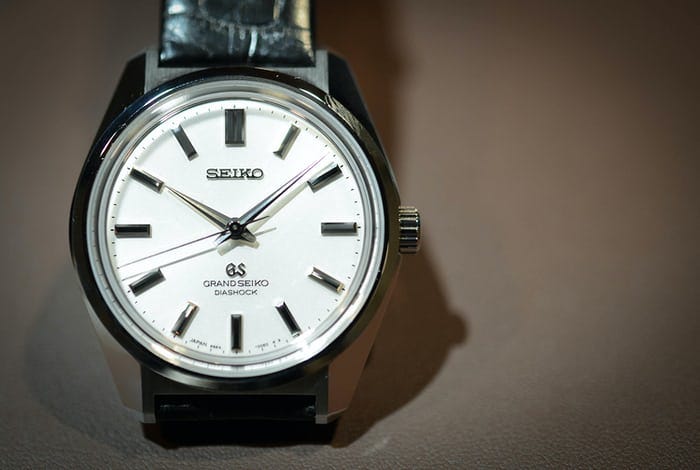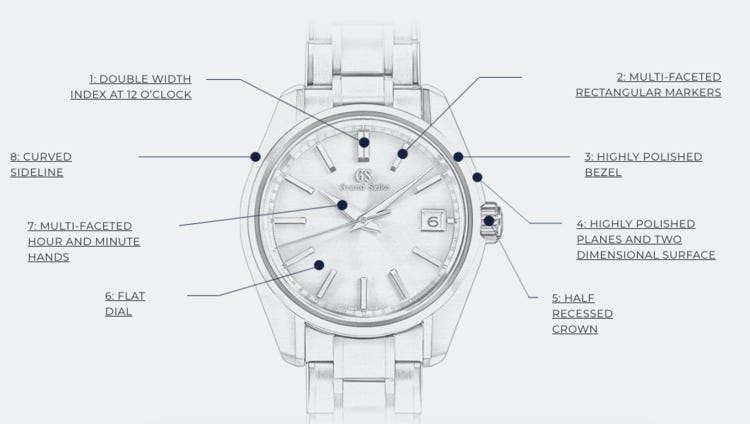Seiko's Grammar of Design: The Art of Impermanence
More on Hamilton v. Vortic, watches of tech billionaires, and why not to pick up a birthday watch
More on Hamilton v. Vortic, watches of tech billionaires, and why not to pick up a birthday watch. If you’re new, subscribe to get Rescapement Weekly in your inbox every weekend:
Properly understanding Grand Seiko’s Grammar of Design can help us appreciate its timepieces for what they are: Art.
Grand Seiko is celebrating its 60th anniversary this year, and with that comes an intensified focus on the brand’s history. Central to that history is Grand Seiko’s Grammar of Design, first developed in 1962 by famed designed Taro Tanaka.
While often compared to Swiss designer Gerald Genta, understanding Tanaka simply as a designer doesn’t fully capture his contributions to watchmaking and to Grand Seiko’s development. To do this, one must understand Tanaka and his Grammar of Design not only as part of Grand Seiko’s history, but as a contribution to a form of Japanese art.
Embracing impermanence
According to Japanese philosopher Keiji Nishitani, there are two forms of art. The traditional Western form strives for permanence: the cathedral built to last thousands of years, the royal portrait commissioned to display ostentatious wealth and power to future generations. Meanwhile, the Japanese form embraces the passing of time. Western art, in trying to deny its intrinsic temporariness, ends up feeling specious: cathedrals fall, portraits fade. These works of art only prove the impossibility of actually achieving permanence. But Japanese art, instead of trying to deny time while in the midst of it, embraces it, encouraging it to move forward.
Nishitani observed this dichotomy writing about ikebana, the austere, delicate Japanese art of flower arranging, contrasting it to the typical Western bouquet, a mass of bright, often conflicting colors. But use your imagination and you might see how it applies to timepieces.
While Nishitani identified this artistic appreciation for the temporary in the Japanese, he observed its presence in other cultures too, especially after periods of industrialization. For example, after World War II, pursuing permanence seemed especially futile. Bombings across the world demonstrated that humanity might willingly destroy anything, anywhere, giving way to a certain existentialism: the Beat Generation, the Minimalist art movement, a desire to find the essence of things, to make sense of the desolation on all sides after the war. This led to a global turn toward Japan’s negative aesthetic — an appreciation of the temporariness that suddenly seemed so present.
It is against this backdrop that Seiko released its first true luxury product, the “Grand Seiko First”, in 1960. Just a year earlier, Seiko had brought in Taro Tanaka as the company’s first trained designer to lead its new design department in reimagining what the company viewed as dull and uninspired designs that failed to compete with Swiss watches in the Western market. While Tanaka’s influence can already be seen in the Grand Seiko First (reference 3180), it is Tanaka’s Grammar of Design, first formulated in 1962, that would go on to define Grand Seiko’s design philosophy to this day.

Art and the Grammar of Design
In Part 1 of of our history of vintage Grand Seiko, we ended by introducing the Grammar of Design. Tanaka had said he wanted Seiko’s luxury watches to “brilliantly sparkle” like their Swiss counterparts. Tanaka defined a design language, dubbed Seiko’s “Grammar of Design” that would go on to define how all future Grand Seiko models were designed, still influencing modern Seiko and Grand Seiko products.
Indeed, modern Grand Seiko’s marketing has done much to tout the historical influence of the Grammar of Design on its offerings. Modern re-issues of the 44GS and 62GS — a couple of the first models to fully realize all of Tanaka’s elements — are the mere tip of the iceberg. The principles of the Grammar of Design now run through the brand’s very DNA.
This Grammar of Design pared back watch design to its core elements and purpose, articulating nine elements, including: (1) flat surfaces and angles to best reflect light, (2) flat, faceted and polished bezels, (3) mirror finishing (Zaratsu polishing) of all case and dial components, (4) unique case shapes (no more generic round designs). These specific elements are directed towards the principle of keeping the watch’s geometry clean, crisp and legible.

Listing some of the Grammar of Design’s elements, one begins to see how Tanaka had an intrinsic understanding of the Japanese form of art articulated by the philosopher Nishitani. The elements relied not on materials or jewels to create luxury products that “brilliantly sparkle”, but on shapes, lines, and Zaratsu polishing. Much like ikebana relies on the selection of a few flowers placed in a handmade ceramic vase, then setting that vase in the blank space of a tokonoma to appropriately frame the artist’s work, Grand Seiko’s products can be fully understood only by zooming out to capture the space in which they exist. The art is simply there, alone, defining itself moment to moment as it interacts with its surroundings.
The Grammar of Design took the Japanese reverence for the negative aesthetic and translated it into a set of principles that could be used to craft a true luxury product. If, up until this point, Seiko had been understood as a manufacturing company, having more in common with Toyota, Mitsubishi or Nippon than with Swiss watchmakers, much less other luxury goods maisons, Tanaka’s principles set out to change that.
Seiko’s Grammar of Design is much more than a set of restrictive instructions on how to design a product. Tanaka created an entirely new approach to watch design that had Japanese identity and philosophy at its core. He created a set of principles that defined Japanese watchmaking as an artistic discipline, alongside other Japanese practices that were already recognized as pursuits to be appreciated in their own right. Japanese watches were no longer products in which design and craftsmanship were an afterthought; these attributes became core to their identity, the expression of the design and of the craftsmen becoming part of the reason for their creation in the first place.
To take the 44GS series (re-edition pictured above) as an example of this expression, one of the first pieces to fully realize all elements of Tanaka’s Grammar of Design. Its elegant simplicity embodies not only Tanaka’s philosophy, but is true to the Japanese approach to art beyond watchmaking. The bezel remains minimal, nothing more than a polished surface. From there, the multi-faceted outer case forms flat surfaces, with the lugs tapering to sharp points. All of these facets have mirror polishing to maximize interaction with light. The dial is similarly reflective, with a simple silver sunburst sitting beneath polished indices and sharp dauphine hands. Taken as a whole, the design is notable mostly for how it interacts with its surroundings — namely, light — consistent with other traditional Japanese art forms which seek to understand objects through interactions with their surroundings.
As the world turned to Japan’s mastery of the negative aesthetic and its appreciation for the transient nature of objects during the post-war era, it follows that it would again recognize the importance of these virtues in a modern era defined by digital consumerism, unpredictable lunatics with nuclear codes, and other touchstones that remind us that the world mostly sucks and we’re wondering this Earth alone.
If watches are to be properly understood as art, worthy of appreciation heaped upon paintings, sculptures or items offered in adjacent auction house departments, they must be interpreted as part of the cultural context in which they were created.
While Tanaka’s Grammar of Design is often discussed in watch collecting circles, it is also important to understand the larger historical context of its development. With this understanding, Grand Seiko’s timepieces can be properly understood as pieces of art consistent with other forms of art and craftsmanship in Japan’s rich history.
Brands and What’s Best: Intellectual Property in the Watch Industry
With the continue discussion of the Hamilton v. Vortic lawsuit, it’s important to remember that collectors all want one thing: whatever’s best for the future of the watch industry.
While legal battles over intellectual property (IP) are often framed as “David vs. Goliath” clashes in which an established, centuries-old brand (think Rolex or one of Swatch Group’s stable of brands) takes up against a young upstart, this misses the point. While it’s easy to assume that support lies largely with Vortic because everyone loves the scrappy upstart, that’s not the underlying factor for most. Principled collectors are concerned not with any one brand, but with progressing the industry and the community as a whole.
While enthusiasts may argue opposing sides in any specific case, these arguments are grounded in the same underlying principle — the same principle of promoting progress that legal IP protection is also designed to incentivize.
Sales Corner
Not the first Tudor “Snowflake,” but one of the most robust. Often compared to its contemporary, the Rolex Submariner Ref. 1680, the blue dial and bezel insert in addition to the bold lume markers give the Ref. 94110 an unusual design all its own.
This Tudor Snowflake is on offer from Tropical Watch, dealer Jacek Kozubek’s new venture. You’ll find all manner of desirable vintage and neo-vintage Rolex on the site.
A jumbo-sized Precimax dive watch with gorgeous broad arrow hands and an internal rotating bezel. It’s worth diving into Super Compressor cases before deciding on this one. Jason Heaton provides a worthy introduction here.
Ticks and Tocks
🎂 On not picking a birthday watch
A beautiful piece from Hodinkee’s Jason Heaton on the occasion of his 50th birthday. As a fellow Midwesterner, this passage in particular resonated:
Where I come from, I didn't see anyone wearing Rolex. While many from the coasts and Europe saw fathers and role models wearing old Subs and Datejusts, in the American Midwest, the Crown is largely seen as ostentatious, impractical, and pretentious. So while I was spending time in New York, Geneva, and more far-flung post codes where Rolex is common, coming back home with one on usually meant having something to explain, if not to others, at least to myself. This forced me to examine what it was that I liked about Rolex specifically, and about watches in general.
Curbed architecture critic Kate Wager writes:
We live in a “throwaway society”—a society that produces cheap, low-quality goods we would rather discard and replace than repair. Though our lives may be replete with fast food, fast fashion, and fast furniture, for every one of us there are special objects that carry deep emotional value and are therefore irreplaceable.
But instead of being prescriptive, this piece ends by posing questions for the reader to ponder: What does it mean to love things? What does it mean to consume?
📚 Book Review: Time for a Change, the vintage Enicar book. 👨✈️ Introducing: The Breitling AVI Ref. 765 re-edition. 🎼 Nomos introduces the Tetra Symphony collection. ⌚️ Watches of the tech sector elite: see what’s on the wrist of Bezos, Dorsey, Ellison and more. 💎 Three bad-ass watches from Uncut Gems. 🤔 The unfinished George Daniels watch.
In Chicago: Curtis Duffy’s next restaurant venture is coming soon.
Thanks for reading!
-Tony
Tap the heart above to like this email, comment, and please share Rescapement Weekly:




